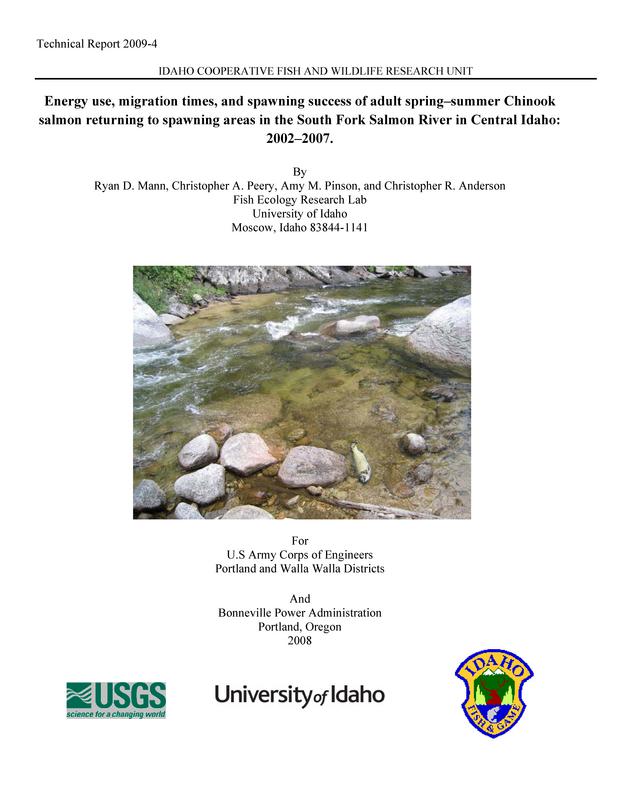PDF
Energy Use, Migration Times, And Spawning Success Of Adult Spring–Summer Chinook Salmon Returning To Spawning Areas In The South Fork Salmon River In Central Idaho: 2002–2007 Item Info
- Title:
- Energy Use, Migration Times, And Spawning Success Of Adult Spring–Summer Chinook Salmon Returning To Spawning Areas In The South Fork Salmon River In Central Idaho: 2002–2007
- Report Type:
- Technical Report
- Date:
- 2008
- Authors:
- Mann, R.D.; Peery, C.A.; Pinson, A.M.; Anderson, C.R.
- Affiliations:
- Fish Ecology Research Lab, University of Idaho
- Report Number:
- 2009-4
- Publisher:
- University of Idaho
- Funder:
- U.S. Army Corps of Engineers, Portland District; U.S. Army Corps of Engineers, Walla Walla District; Bonneville Power Administration
- Abstract:
- The accuracy and feasibility of multiple methods for determining energy condition in Chinook salmon were determined. These results were compared to proximate analysis of fish tissues, which represented the true value of energy content for these fish. Although all estimate methods produced results that were significantly correlated with proximate analysis, bioelectrical impedance and condition factor were less accurate than morphometrics and the Distell Fatmeter. Bioelectrical impedance did not seem to be as accurate in salmon as with other fish species, and is generally considered of better use for mammals. Although condition factor was included as a factor in many models to predict energy condition, its lipid estimation qualities by itself are suboptimal. From a series of 12 morphometric measures, breadth at anus, hump height and mideye to hyperal length together provided the best method for determining lipid content. These three measures were used in subsequent years. Although morphometrics proved to be the most accurate method for estimating energy condition, the Distell Fatmeter was also accurate, and had the added benefit of a reduced handling time. Either of these two methods are recommended to be used in further research when a quick and accurate measure of lipid content is needed.
- Species:
- Chinook salmon, Oncorhynchus tshawytscha
- Location:
- South Fork Salmon River; Columbia River; Lower Snake River
- Subjects:
- salmonids Federal Columbia River Power System FCPRS radiotelemetry migration PIT tags passage behavior bioenergetics condition reproduction
- Source:
- University of Idaho, Fish Ecology Research Lab
- Original Filename:
- 2009-04-CK-migration-energy-use-spawning-success-South-Fork-Salmon-2002-2007.pdf
- Format:
- application/pdf
Source
- Preferred Citation:
- "Energy Use, Migration Times, And Spawning Success Of Adult Spring–Summer Chinook Salmon Returning To Spawning Areas In The South Fork Salmon River In Central Idaho: 2002–2007", Adult Salmon and Steelhead Migration Studies: 1996-2014, University of Idaho Library Digital Collections, https://www.lib.uidaho.edu/digital/ferl/items/ferl-tr-2009-4.html
Rights
- Rights:
- These files are provided for research purposes with copyright held by the original authors. Please contact the publishing organization for more information about rights.
- Standardized Rights:
- http://rightsstatements.org/vocab/InC-EDU/1.0/

